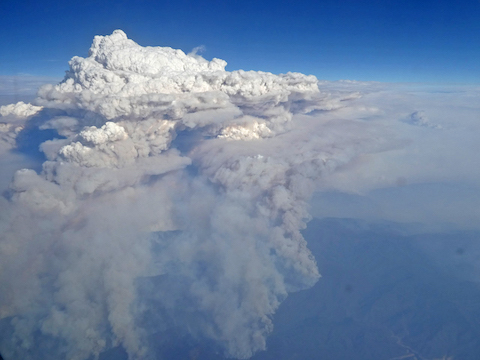
The Australian bushfires of 2019 produced so much smoke, it entered the stratosphere, 19 miles above Earth!
On an earlier episode, we talked about how fires make their own weather. As a column of hot air rises from the flames, it carries smoke into the atmosphere where it forms clouds.
Water vapor may condense around smoke particles and rain down to quench the fire. Or lightning may form in the clouds, which could cause more fire risk.
The Australian fires produced 100 million tons of smoke. The updraft was so strong, it carried this smoke up through the troposphere—the lowest layer of our atmosphere where weather occurs—and into the stratosphere.
The stratosphere is less turbulent than the troposphere, so particles tend to hang around much longer; the Australian smoke plume lasted for more than 6 months. It was vast enough to be seen easily from the space station.
Previous ash and aerosol clouds have entered the stratosphere from volcanic eruptions and other fires. These have cooled the planet by as much as 1 degree Fahrenheit by reflecting sunlight. Or warmed it by as much as 2 degrees by absorbing sunlight.
Scientists are still studying the Australian smoke plume to better understand these cooling or warming effects—and the potential impacts if humans were to introduce particles into the stratosphere to try to moderate Earth’s temperature in what’s called geoengineering.
Background
Synopsis: During Australia’s Black Summer of 2019–2020, bushfires raged on the continent, ravaging an area the size of Washington State. Huge plumes of smoke created their own weather, forming pyrocumulus and pyrocumulonimbus clouds. Black carbon entrained within these clouds trapped heat, propelling them farther upward until they punched into the horizontally layered stratosphere, injecting as much smoke as some volcanic eruptions.
- Australia’s Black Summer was unprecedented in its intensity for as long as records have been kept.
- Major bushfires began in June 2019 and burned for nine months until all the fires were finally contained on March 4, 2020.
- The fires consumed 46,000,000 acres (72,000 sq mi or 186,000 sq km), equivalent to the size of the U.S. state of Washington or the country of Syria.
- The bushfires killed an estimated one billion animals with some endangered species losing more than 30% of their habitat and facing extinction. More than a third of the Koala population is believed to have perished.
- More than 9,350 structures were destroyed, and 34 people were killed by the fires, while 445 died of smoke inhalation.
- Property damages and economic losses topped US$75 billion with almost 80% of Australians impacted in some way.
- The intense fires generated their own weather (ED-111), producing towering pyrocumulus and pyrocumulonimbus clouds.
- As heat rises from a fire, the air around its base rushes in, feeding the smoky superheated updraft plume.
- As the plume rises and spreads out, it cools, causing water vapor in the atmosphere to condense on smoke particles creating clouds.
- Carbon in the smoke particles further heats the clouds, causing them to rise higher and higher.
- These smoky clouds may grow into pyrocumulonimbus clouds that create additional fire danger because of their associated lightning.
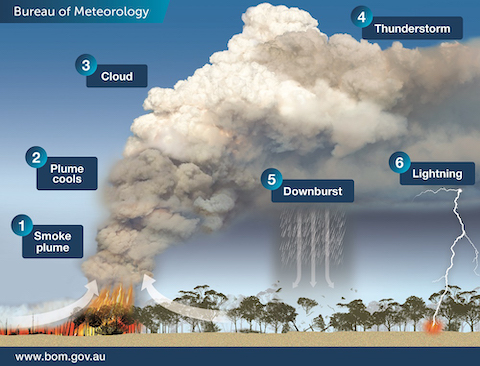
Pyrocumulonimbus cloud development Credit: Australia Bureau of Meteorology
- In December 2019 and January 2020, the bushfires were so intense that their pyrocumulonimbus clouds and smoke punched through Earth’s troposphere into our protective stratosphere.
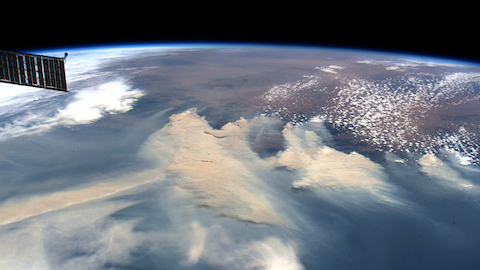
Image of the smoke produced from the bushfires in the forests of Australia taken from the International Space Station at an altitude of 424 km on January 4, 2020. Credit: NASA ISS, via Wikimedia Commons - We live in the lowest level of Earth’s atmosphere, the troposphere, where turbulent vertical mixing causes our weather to occur. It ranges from 4–12 mi thick (7–20 km), is thicker at the equator and cools with increasing altitude.
- Above the troposphere is the stratosphere, Earth’s protective blanket that contains 90% of the planet’s UV absorbing ozone (O3).
- The stratosphere is strongly temperature stratified because its ozone absorbs UV radiation, warming upwards to its top around 31 mi (50 km) above the ground.
- This stratification prevents vertical mixing and promotes horizontal mixing and lateral dispersion, and once particulates reach this atmospheric layer they stay for a long time.
- Temperature plummets again above the stratosphere in the mesosphere. The thermosphere and exosphere are the final two layers of Earth’s atmosphere.
- The volume of smoke particulates injected into the stratosphere by the Black Summer fires rivaled the volume of ash and aerosols produced during the 1991 eruption of Mount Pinatubo in the Philippines.
- On June 1991, Mount Pinatubo blasted more than 1 cu mi (5 km3) of ash and 20 million tons of sulfur aerosols as high as 28 mi (40 km) into the stratosphere where they spread out laterally circling the globe.
- This resulted in a global temperature drop of nearly 1oF (0.5oC) that lasted about 2 years and a yearlong perturbation of the ozone layer.
- The New Year smoke plumes reached altitudes of up to 19 mi (31 km) and widths of 620 mi (1,000 km), circling the Southern Hemisphere within the stratosphere for months.
- The Australian bushfire plumes injected nearly a million metric tons of smoke into the stratosphere—the largest volume ever observed in the satellite era.
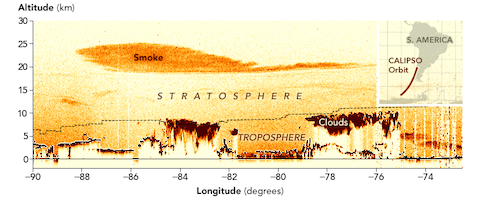
On January 23, 2020 the NASA/CNES CALIPSO satellite measured the height of the smoke plume (in orange) as high as 25 km near southern South America. The dashed line shows the boundary between the troposphere and the stratosphere. Brown weather disturbances are visible within the troposphere. Credit: NASA Earth Observatory - In just two weeks, the smoke plumes drifted eastward from Australia, turning the skies of New Zealand bright orange, crossing the South Pacific to South America, then the South Atlantic to South Africa, finally returning across the Indian Ocean to Australia from the west just two weeks later.
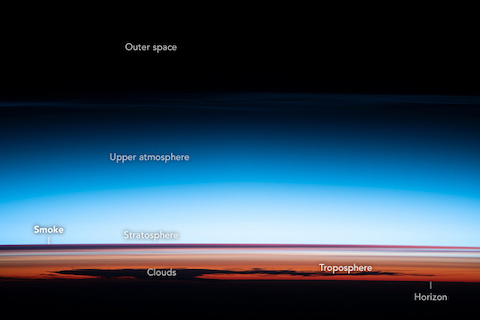
On February 12, 2020 astronauts in the International Space Station captured this photgraph of smoke in the stratosphere over the South Atlantic Ocean. Credit: Smoke in the Stratosphere | NASA Earth Observatory - The plumes continued to circle the globe for at least four months before they became difficult to discern from other plumes.
- The Australian bushfire plumes injected nearly a million metric tons of smoke into the stratosphere—the largest volume ever observed in the satellite era.
- Researchers are studying the impact of this quantity of smoke on the stratosphere.
- The smoke could cause a cooling effect by reflecting incoming solar radiation, it might cause local heating by absorbing solar radiation, and it could impact the ozone layer by displacing ozone or by reacting with ozone.
- Models suggests that the smoke probably circled the globe for most of 2020, warming the stratosphere by around 2oF (1oC) for about 6 months.
- The smoke caused a 4–6% decrease in ozone layer thickness in the Southern Hemisphere, temporarily increasing the size of the Antarctic ozone hole.
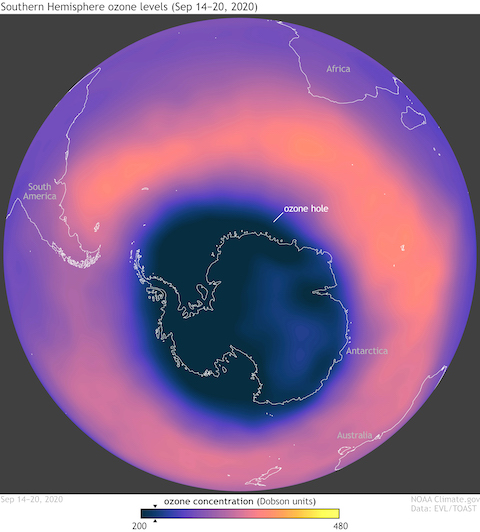
This data visualization shows the extent of the Antarctic ozone hole in September 2020, exacerbated by stratospheric smoke from Australia’s Black Summer bushfires. Credit: NOAA Climate.gov - In 2017, a smoke plume event from the Pacific Northwest resulted in dimming and cooling effects. Study is ongoing on this potential longer-term impact.
- As bleak as it may sound, these studies help our understanding of the consequences of future volcanic eruptions or nuclear wars.

